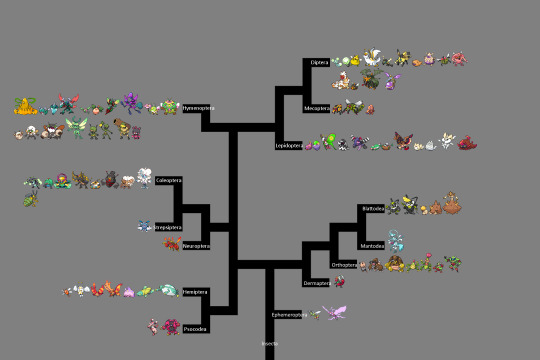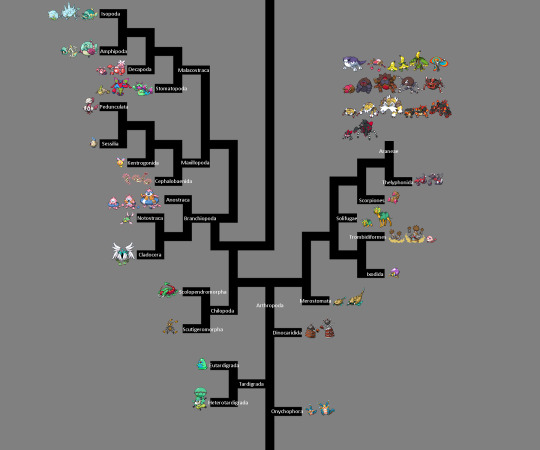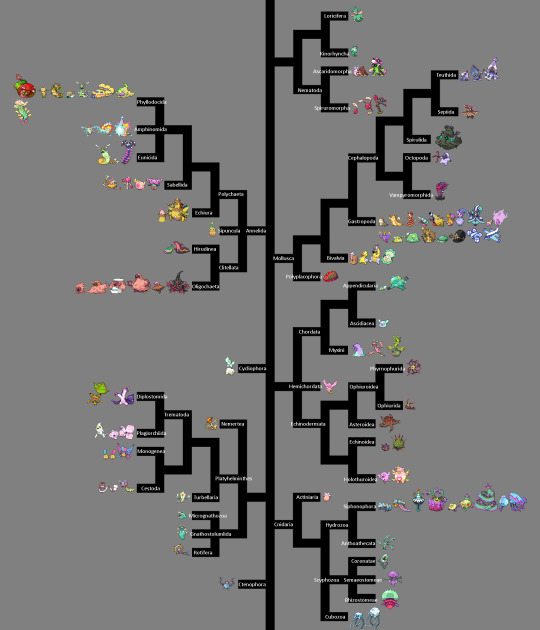#taxonomy and phylogenetics
Text
Note to self:
Start finding and making a list of women in ichthyology.
All the big names that come to mind off hand are men.
#feel free to suggest if you happen to know some#otherwise this really is just a note to self#but also i mean ichthyologists specifically and not just any scientist that srudies fishes in some capacity#looking for systematics ladies#taxonomy and phylogenetics#the earlier and better known the better
6 notes
·
View notes
Text
Below the poll is a series of animal images labeled A through J. A is the least close to the birds we have today; J is the closest. If you encountered these animals in the wild, which would you call birds? If you pick a higher up option, then that means you consider all the below ones birds as well - so if you pick A, then BCDEFGHIJ are all birds. If you pick J, only J is a bird.
A:

B:
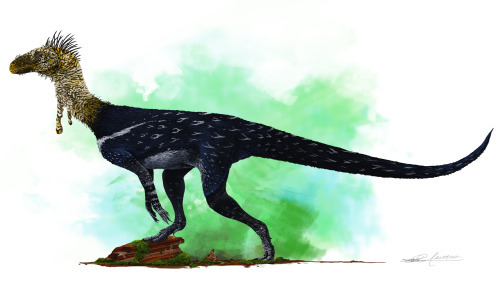
C:

D:

E:
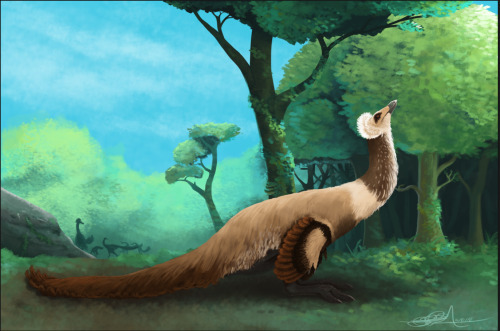
F:
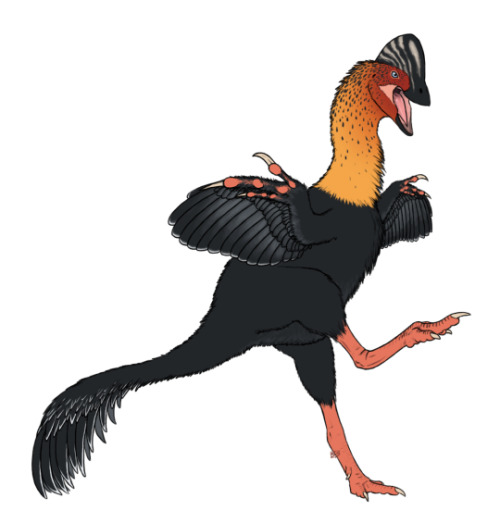
G:

H:
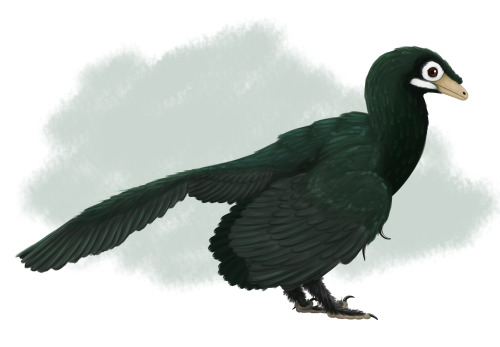
I:
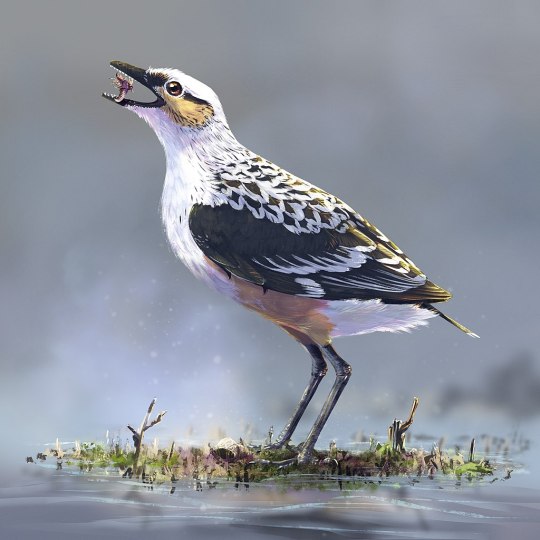
J:

PLEASE REBLOG THIS SO IT CAN LEAVE PALAEOBLR. I NEED PEOPLE WHO DON'T RECOGNIZE THESE ANIMALS ON SIGHT TO VOTE.
I apologize to all of y'all with vision impairments for whom this poll is inaccessible. Alas, this is an experiment, and I cannot name the taxa. Thank you.
All alt text includes artist attribution; I did not make these pictures myself.
#palaeoblr#dinosaurs#birds#pterosaurs#prehistoric life#WHAT ARE BIRDS#bird political spectrum#taxonomy#classification#cladistics#phylogenetics
19K notes
·
View notes
Text

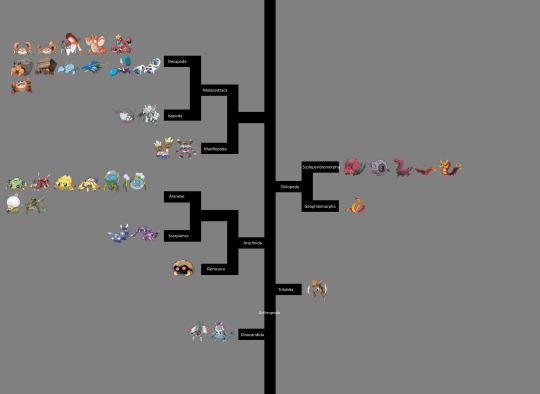

Phylogenetic Tree of Invertebrate Pokemon (Gen 9 Edition)
3K notes
·
View notes
Text
Monsterverse Titan Phylogeny & Taxonomy

So, I was bored, and instead of studying for an upcoming test, I procrastinated and made a phylogenetic tree (a Tree of Life) and some proper scientific names for the Titans we have seen in the Monsterverse! The names in the official canon make no taxonomic sense. Titanus mosura and Titanus behemoth sound cool and all, but that implies that all the Titans are the same Genus, which.... no. Just, no.
I hope you guys enjoy it! I am always happy to answer any questions you have about it in the comments.
Scientific Names:
Shinomura - Parasitas collonium (parasitic colony)
Na Kika - Polypusoccult iridescentia (secret iridescent octopus)
Scylla - Lolligan testa (giant squid with legs)
Mothra - Vespulinea luxideu mosura (wasp light-god Mothra)
MUTO - Magnenator phagos (magnetic eater eater)
Amhuluk - Daemopampinus deceoculi (demon tendril with ten eyes)
Methuselah - Montivitae cornutum (living mountain with horns)
Skull Crawler - Reptant cranium (basic reptile skull)
Ion Dragon - Dracdum pisicut (fish-like ion dragon)
Tiamat - Serpensbellum tempestas (war serpent of storms)
Rodan - Pyranodon ventus (toothless winds of fire)
Doug - Deumigale optimum (best god gecko)
Shimo - Deureptilus glaciei (god reptile of the ice)
Godzilla - Deureptilia solis gojira (god reptile of the sun)
Behemoth - Dentesimia mehemot (tusked ape behemoth)
Frost Vark - Nasasidus fodiens (star nose digger)
Camazotz - Solhostis vespermortem (sun enemy death bat)
Skar King / Suko - Deupithepongo sapiens (wise god orangutan)
Kong - Deupithecus sapiens (wise god ape)
ALSO: Because Ghidorah is not of Earth, he wouldn't be ANYWHERE on a phylogenetic tree of Earth animals. Nowhere close at all. But his scientific name could be Interfectorum inanis (void killer).
#monsterverse#godzilla#legendary monsterverse#biology#taxonomy#Linnean classification#scientific names#science#proper science#phylogeny#phylogenetic tree#tree of life#doug#shimo#kong#skar king#discussion#science literacy#headcanons#rodan#mothra
29 notes
·
View notes
Text

It’s finally here! The new and improved 2023 version of my Piscine wyverns, most leviathans, and true elder dragons phylogenetic tree.
There is quite the substantial difference between this version and the older ones. Each species profile is also more in depth than my last tree, the flying wyvern tree, because there’s a lot more room for speculation in these monsters. A lot of this is also recontextualizing and reworking many outlandish traits some of these monsters have and basically giving a lot of canon/what some of the hunters guild tells us the middle finger. Some of the scientific names for the families were made by my fellow poopenshitter TheCuriousOne. They came up with the names for their own tree and allowed me to use some of these names too.
Because the written description is almost 100,000 characters long, I had to put it in a google doc that you can read here! I even added a chapter index so you can skip to the families you want to read.
This is probably the most in depth monster hunter cladogram on the internet
#monster hunter#monster hunter biology#monsterhunter#monhun#speculative evolution#speculative biology#speculative zoology#speculative anatomy#phylogeny#phylogenetics#phylogenetic tree#taxonomy#cladogram#cladograms#elder dragons#piscine wyverns#leviathans#monster hunter rise#monster hunter world
103 notes
·
View notes
Text
About the "shrimp is bugs" meme. Taxonomically we try to classify things based on evolutionary ancestry, creating groups called 'clades'. A clade is made up of the last common ancestor for the group and all of the descendants of that ancestor. This system is 'hierarchical', so multiple smaller clades can fit within one larger one. E.g. humans are part of the clade hominoidea, which also includes other apes like chimpanzees and gorillas.
Shrimp and bugs are both arthropods (a clade), but although 'bugs' are a clade (called 'hemiptera') within insects (also a clade within arthropods), 'shrimp' is basically a catch-all term for 'small long-bodied crustacean' (so shrimp don't form a clade).
What's interesting is, until recently crustaceans (including shrimp and a bunch of other things) were thought to form their own clade. But DNA studies have shown that some crustaceans are more closely related to insects (again, including bugs) than they are to other crustaceans. So for our taxonomy to be consistent we'd have to consider all insects as crustaceans.
So shrimp isn't bugs, but in a roundabout way bugs is shrimp.
22 notes
·
View notes
Text

i had to share this convo i had with a friend from undergrad
absolutely incomprehensible drivel. i love biology.
(CONTEXT: we were both entomology majors together and i'm currently creating slides for a guest lecture on arthropod systematics. arachnids are a notoriously controversial group because scientists can't agree on whether horseshoe crabs get to be in the club or not. i was reading an absolute taxonomic smackdown of a paper and had to share)
TL;DR nerd shit
#arachnids#taxonomy#phylogeny#biology#phylogenetics#arthropods#invertebrates#entomology#but more like#arachnology#nomenclature#nerd shit#mine
11 notes
·
View notes
Text

[Image ID: a speculative phylogenetic tree for all living things in Minecraft, including mobs and any "plant" or "fungus" lifeforms. The phylogenetic tree is illustrated using images from the game. The three highest domains are: Gramina, including grasses, vegetables, and most trees; Prismata, including creepers, slimes, and squids; and Velamina, including all fungi-like lifeforms, most animals, symbiotes (Wither and golems), and flowering plants. /.End ID]
Minecraft evolutionary tree of life, inspired by this one by NitroHydroRay. But in this one, life evolved very differently than it did on our world (it is UNHINGED). Click to zoom.
The clades are all invented, and I tried to name most clades (the ones lower than the three highest domains) according to the zoological guidelines: purple = superfamily, blue = family, green = subfamily, yellow = tribe, orange = subtribe.
#minecraft#speculative evolution#minecraft evolution#phylogeny#minecraft taxonomy#taxonomy#speculative taxonomy#medieval bestiary#phylogenetic tree#evolution#speculative biology
6 notes
·
View notes
Text
if i was a twitch streamer i would stream myself making a phylogenetic tree for the subnautica creatures
#would anyone watch that? probably not. do i care? no because i wanna do it so badly#i havent made a phylogenetic tree since college and i miss having excuses to do this.#also i just watched a 2 hr video essay on the biology of subnautica and was highly disappointed by it#not NEARLY enouhj detail. they basically just read the scan entries and compared things to earth creatures#which is like. fine. but i want MORE#unfortunately i am neither funny nor well-spoken enough to be a content creator of any kind#anyway. i love you taxonomy i love you alien biology
4 notes
·
View notes
Text
Don’t want to clown on an otherwise perfectly good post but not every clade is universally defined solely by empirical phylogenetic/genetic evidence. For example, the foremost authoritative taxonomy of amphipods is based entirely on morphology-based cladistic methods, which nearly every recently published phylogeny has disrupted, and yet still remains because it takes time and peer review to update official linnean names for higher taxa. This is the case for a whole lot of groups of organisms where funding for genetic resource acquisition is low, or whose taxonomy has been dominated by a few stubborn old morphologists…
#that last point deserves a paragraph all its own#source: I study a group with poorly-developed genetic resources#it’s getting better but there are some people who seem to call the shots on taxonomy and they haven’t historically put in the effort#to define clades phylogenetically#don’t get me wrong their work has been super formative and presents a lot of interesting hypotheses to test#but it’s frustrating when you see a family that everyone knows is paraphyletic still listed on WoRMS#sorry I didn’t know I had this all inside me#Collin does science
3 notes
·
View notes
Note
do you know any cool moth facts? i totally understand if not, i just wanna get over my phobia by noticing how cool they r ^_^
thanks ! have a good day
“moths” is a huge category of animals, so if you were asking for cool adaptations in particular species you’ll have to be more specific because it’s impossible for me to know where to start!
but a few general moth facts:
moths have been around a long time, and some basal types still exist that have mandibles (like the usual bug mouthparts you see in beetles/ants) instead of a tube proboscis for drinking nectar like most of the big moths you see. these moths are all super tiny and mostly eat pollen.
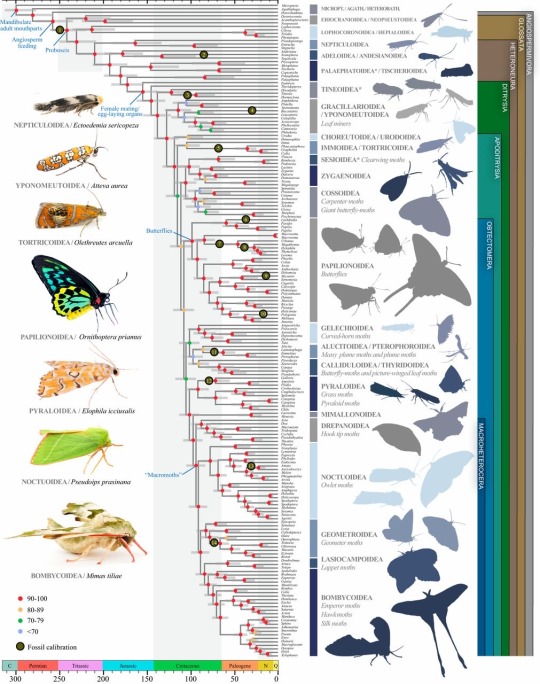
as you can see from this phylogenetic tree, butterflies are moths! or rather “butterfly” is just the English word for a particular group of diurnal Lepidoptera, sort of like how birds are a particular group of dinosaurs (but it’s not common to refer to them as such outside of taxonomy or a joke)
most moths are nectar-feeders, but others feed on decaying fruit, tree sap, or honeydew, and silkmoths and many hawkmoths do not feed at all as adults, relying on larval fat reserves to power them through their brief adult lives
there are numerous diurnal moths, beyond just the butterflies. family Uraniidae are some of the most dramatic:
moths have some of my favorite mimicry examples of any group of insects:
many moths mimic bird poop (birds aren’t likely to look for meals out of their own poop!) but Macrocilix maia takes it a step further and has patches of colored scales that look exactly like red-eyed, shiny-winged flies eating the bird poop!
a number of tiny moths’ wings mimic jumping spiders, which might seem an odd choice until you realize that jumping spiders—predators of these moths—have excellent facial recognition. even if the jumpers would eat another spider, the oOOo pattern tricks them into thinking their that spider is looking right at them, and can’t be taken by surprise.
phylotree from: https://www.pnas.org/doi/10.1073/pnas.1907847116
moth enthusiasts: feel free to add cool moth facts if you’d like!
661 notes
·
View notes
Note
Birds are class Aves.
Sure, under Linnaean taxonomy. But, well,
A) Linnaeus was a eugenecist so his scientific opinions are suspect and his morality is awful
B) he didn't know about evolution
C) he didn't know about prehistoric life
so his classification system? Sucks ass. It doesn't work anymore. It no longer reflects the diversity of life.
Instead, scientists - almost across the board, now - use Clades, or evolutionary relationships. No rankings, no hierarchies, just clades. It allows us to properly place prehistoric life, it removes our reliance on traits (which are almost always arbitrary) in classifying organisms, and allows us to communicate the history of life just by talking about their relationships.
So, for your own edification, here's the full classification of birds as we currently know it, from biggest to smallest:
Biota/Earth-Based Life
Archaeans
Proteoarchaeota
Asgardians (Eukaryomorphans)
Eukaryota (note: Proteobacteria were added to an asgardian Eukaryote to form mitochondria)
Amorphea
Obazoa
Opisthokonts
Holozoa
Filozoa
Choanozoa
Metazoa (Animals)
ParaHoxozoa (Hox genes show up)
Planulozoa
Bilateria (all bilateran animals)
Nephrozoa
Deuterostomia (Deuterostomes)
Chordata (Chordates)
Olfactores
Vertebrata (Vertebrates)
Gnathostomata (Jawed Vertebrates)
Eugnathostomata
Osteichthyes (Bony Vertebrates)
Sarcopterygii (Lobe-Finned Fish)
Rhipidistia
Tetrapodomorpha
Eotetrapodiformes
Elpistostegalia
Stegocephalia
Tetrapoda (Tetrapods)
Reptiliomorpha
Amniota (animals that lay amniotic eggs, or evolved from ones that did)
Sauropsida/Reptilia (reptiles sensu lato)
Eureptilia
Diapsida
Neodiapsida
Sauria (reptiles sensu stricto)
Archelosauria
Archosauromorpha
Crocopoda
Archosauriformes
Eucrocopoda
Crurotarsi
Archosauria
Avemetatarsalia (Bird-line Archosaurs, birds sensu lato)
Ornithodira (Appearance of feathers, warm bloodedness)
Dinosauromorpha
Dinosauriformes
Dracohors
Dinosauria (fully upright posture; All Dinosaurs)
Saurischia (bird like bones & lungs)
Eusaurischia
Theropoda (permanently bipedal group)
Neotheropoda
Averostra
Tetanurae
Orionides
Avetheropoda
Coelurosauria
Tyrannoraptora
Maniraptoromorpha
Neocoelurosauria
Maniraptoriformes (feathered wings on arms)
Maniraptora
Pennaraptora
Paraves (fully sized winges, probable flighted ancestor)
Avialae
Avebrevicauda
Pygostylia (bird tails)
Ornithothoraces
Euornithes (wing configuration like modern birds)
Ornithuromorpha
Ornithurae
Neornithes (modern birds, with fully modern bird beaks)
idk if this was a gotcha, trying to be helpful, or genuine confusion, but here you go.
all of this, ftr, is on wikipedia, and you could have looked it up yourself.
671 notes
·
View notes
Text
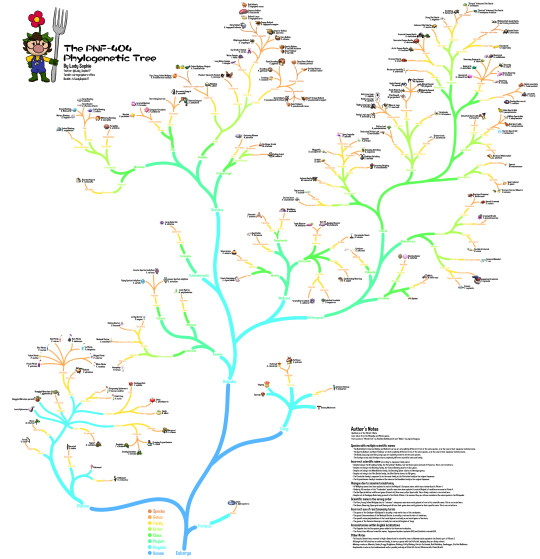
The PNF-404 Phylogenetic Tree
A bit of a different post from the usual, as I have been very hyped for Pikmin 4! Here's my speculative phylogenetic tree for most of the creatures in the Pikmin series. It is a bit more cautious than an actual phylogenetic tree, so there are a lot of soft polytomies (ideally every branch split should only have two children), but I digress.
Edit
It seems that Tumblr's compression did some nasty work on my post, so I'm gonna leave here a link to my phylogenetic tree in case anyone would like to see it in its full glory.
Here are also all the notes on the image in case anyone needs those too:
Author's Notes
Updated as of the Pikmin 4 Demo.
Icons taken from the Pikipedia and Pikmin games.
Fonts used are “Pikmin Font” by TheAdorableOshawott and “Dimbo” by Jayvee Enaguas.
Species with multiple scientific names
The Red Bulborb, Empress Bulblax and Bulborb Larvae are all explicitly different forms of the same species, as is the case in their Japanese technical name.
The Spotty Bulbear and Dwarf Bulbear are both explicitly different forms of the same species, as is the case in their Japanese technical name.
The Baldy Long Legs and Hairy Long Legs are explicitly stated to be the same species.
The Centipare and adult Centipare have completely different scientific name and family.
Incorrect scientific name (according to Japanese family name)
Despite being in the Breadbug family, the Fiery Dwarf Bulblax, has the Oculus genus instead of Pansarus. This is corrected here.
Despite not being in the Blowhog family, the Tusked Blowhog shares its Sus genus.
Despite not being in the Mandiblards family, the Shooting Spiner shares its Himeagea genus.
Despite not being in the Flint Beetle family, the Glint Beetle shares its Pilli genus.
The Floaterbie family is supposed to be the same family as the Flutterbie family in the original Japanese.
The Crysanthemum family is considered the same as the Dandelion family in the original Japanese.
Changes due to assumed consistency
All Wollyhop names have been updated to match the Wolpole's European name, which was standardized in Pikmin 4.
Similarly, All mentions of the “frodendum" specific name have been updated to match Wolpole's frondiferorum name in Pikmin 4.
The Red Spectralid has a different genus (Fenestrati) than every other Spectralid. This is likely a mistake is corrected here.
Despite not all Candypop Buds being present in the Pikmin 4 Demo, it is assumed they are all now considered the same species in the Piklopedia.
Scientific name in the wrong order
The Fiery Young Yellow Wollyhop has its “volcanus" subspecies name incorrectly placed in front of its scientific name. This is corrected here.
The Queen Shearwig, Speargrub and Sheargrub all have their genus incorrectly placed as their specific name. This is corrected here.
Incorrect use of real taxonomy terms
The genus Chilopoda of the Centipare is actually the real world class of the centipedes.
The genus Stauromedusae of the Medusal Slurker is actually a real world order of cnidarians.
The specific name phytohabitans of the Leech Hydroe is actually a real world genus of bacteria.
The genus of the Common Glowcap is actually the real world kingdom of fungi.
Inconsistencies within English localizations
The Coppeler has the Scarpanica genus added in the American localization.
The Armurk has different scientific names: Tegoparastacoidea reptantia (US) and Scalobita rotunda (EU).
Other Notes
The Caustic Dweevil was renamed to Hydro Dweevil and its scientific name to Mandarachnia aquadis in the Switch port of Pikmin 2.
Although the Puffstool has no confirmed family, it shares a genus with the Puffstalk, implying they are likely related.
Missing creatures: Mamuta, Smoky Progg, Blubbug, Puffy Blubbug, Electric Cottonade, Red Blubblimp, Seedbagger, Stuffed Bellbloom.
Unplaceable creatures (extradimensional and/or possibly entirely artificial life forms): Waterwraith, Plasm Wraith.
237 notes
·
View notes
Text

The new 2022 Flying Wyvern tree, with much more in depth explanations for the families and an overview for every monster (this is a very long post). Some things had to be chosen or ignored due to the inconsistent nature of monster designs and wing anatomy. Links to the previous version and first pencil and paper tree.
The Common Ancestor
My hypothesized ancestor of flying wyverns and likely even most bird wyverns (or was at least closely related to it) would have been a small paravian dinosaur. This creature, related to troodontids, dromeosaurs, and birds, would have been fully feathered and likely very similar to its relatives save for its arms. The arms of this creature would have been a little more like those of Scansoriopterygids, with a styliform supporting a membrane, but with shorter, more robust hands like those of larger theropods and a little more flexibility in the forearm and wrist region. These adaptations would have allowed it to occasionally walk on all fours in a somewhat pterosaur-like gait or tigrex-like gait, and allowed it to climb trees and even burrow somewhat. This small jack of all stats creature would be one of the few dinosaur families to survive the KT extinction event (yes I think the same extinction events that happened irl happened in monhun), and would be destined for greatness. In later descendants many would lose the gastralia and have a proper waist, and the styliform would gain joints and even duplicate, forming false fingers in addition to the three true fingers. So I will be referring to the styliforms as “Pseudophalanges”.
The God Wyverns
Early on in the evolutionary history of flying wyverns after the KT extinction there was a split between flying wyverns that stayed somewhat small and able to climb and glide, and flying wyverns that became entirely land dwelling and fully quadrupedal. These entirely ground dwelling wyverns eventually became the family of long lived, massive, and powerful wyverns we know today as the god wyverns. These animals are so powerful that most elder dragons avoid them and some were mistaken as dragons as well. It was likely that they were more numerous in the past, but today there are only six genre alive.
The origin Wyvern: One of the most ancient flying wyverns, it shared a common ancestor with modern day god wyverns, but is a long since extinct species only known from sparse remains. What it looked like isn’t something scientists are 100% certain on, but it likely had many features in common with prehistoric and anatomically primitive wyverns like tigrex, Wyvern rex, and akantor.
Akantor: One of the most primitive flying wyverns species still alive in modern day. The species are held in reverence and fear by people who live close to akantor territory, and they are even called the “Infernal Black Gods”. It’s easy to see how these volcanic apex predators earn their reputation, but interestingly they have articulate spines on their back. This anti predator defense implies that in the recent past there was larger predators that preyed on akantor. What exactly these predators were are unknown, but likely were either powerful elder dragons such as black dragons or dalamadur, larger god wyverns, or massive tyrannosaur brute wyverns related to the owner of the massive skull in the Jurassic frontier.
Ukanlos and the Sand/Mountain wyvern: These are two very closely related wyverns, possibly even being in the same genus and having diverged from each other after the end of the most recent ice age. Both have very similar craniums and are adapted to deserts, albeit ones of vastly different temperatures. Ukanlos is adapted to polar regions and is even semi aquatic, using its large fat stores and extensive avian respiratory system to remain buoyant and carving through ice sheets with its jagged shell. The Sand Wyvern is adapted to the harsh equatorial deserts and is more lean and combats heat exhaustion via two organs protruding from its back, possibly being able to flush with blood like many primitive wyverns like akantor and tigrex. We have never faced a Sand Wyvern in any of the games.
Odibatorasu: A god wyvern with an extensive shell and chin like the aforementioned Ukanlos and Sand wyvern, and might even be related to them. To avoid competition with the sand wyvern, Odibas are durophages. Interestingly, they have modified their avian respiratory system by using some of the air sacks in their back to launch sand from the front of their shells like a canon. This is not the only time a flying wyvern has repurposed air sacks. Reports of this monster are greatly exaggerated, as is usual for any report given by a Mezeporta hunter. Hunters from Mezeporta have been a constant thorn in the side of the scientific community, as they seem to prioritize being seen as superhuman legends that regularly kill supernatural gods than being protectors of villages and scientific assistants. So far they have not been found guilty of illegal hunting activity, but the hunters guild is searching for any excuse to send Guild Knights after them.
Keoaruboru: A very poorly known god wyvern. So little is known about it that the guild still has it classified as an elder dragon, although its forearms betray its ancestry. Not much else can be said due to a lack of reliable information as they have only been encountered by Mezeporta hunters.
Bogabadorumu: Another poorly known god wyvern. It has modified its air sacks to spew explosive gas out from vents, not unlike magnamalo. Some individuals have 4 fingers, and the presence of four fingers on a maniraptorian is odd, but it is because of a mutation that sometimes occurs in quadrupedal wyverns. Some god wyverns and “pseudowyverns” are born with a second first digit, and in many cases this digit is so small it doesn’t even touch the ground.
Wyvern Rex and the Tigrex/Barioth Family
The other side of the first big split in the flying wyvern family, these wyverns that were able to climb and glide eventually became larger fully ground dwelling creatures just like the god wyverns, but didn’t grow as large as the god wyverns and kept their large Pseudophalanges and wing membranes.
Wyvern Rex: One of the earliest known member of this family and just like the origin wyvern it was already quite anatomically distinct from its more bird-like ancestors, indicating that there are gaps in the fossil record for flying wyverns.
Pariapuria: This wyvern is quite unusual and split off early in comparison to its non-god wyvern relatives. Parias are semi-aquatic and seem to have stayed that way for a large portion of their evolutionary history, and even evolved semi permeable skin covered in mucus in between their scales. They also have very strange and violent digestive systems and a unique way of processing poisons. Instead of using their liver they seem to be able to separate poisons from food in their stomach and then vomit them back up. This has resulted in their livers becoming smaller over time.
Tigrex: One of the most famous wyverns, the appearance of the nomadic tigrex has changed little over its evolutionary history. It’s behavior, size, and internal anatomy has though. Its ancestors likely weren’t as large or nomadic, and could have even been slightly feathered like many related pseudowyverns. Tigrex has also evolved a highly specialized larynx and syrinx in order to create and withstand their iconic calls, and their trachea loops far back into their body in order to provide enough space for their calls to resonate like whooping cranes. The calls of this wyvern, and other extremely loud monsters like Akantor, can actually cause hearing and internal organ damage in humans, and in some cases even hit the once hypothesized “brown note”; a sound frequency that makes a human lose control of their bowels.
Diorekkusu: A Wyvern genus very closely related to tigrex, “Diorex” are quite distinct in their anatomy and native range. Unlike tigrex, Diorex are only found in the great forest and have very weak shells with little in the way of pigmentation. Instead they protect themselves with electrical organs and ores they attach to their bodies via electromagnetism. As expected of Mezeporta hunters, recounts of this monster are unreliable.
Dyuragaua: These wyverns are distinct for their odd colorations and cryogenic abilities. Their colors are thought to be a warning against predators due to their toxins that induce sleep.
Mi Ru: Very little is known about these wyverns. Due to the fact they’re only found near the Tower (a megastructure built by the ancient civilization out of Kushala Daoras) and that they have shape shifting abilities, some scientists think they might have been modified from a now extinct Dyuragaua relative, although this has not been accepted by the larger scientific community. Despite the appearance of Mi Ru and Dyuragaua, they are actually closer related to Barioths than they are to Tigrex (although still closely related) due to their convergently more mammalian facial features and that Mi Ru has pinnae derived from cartilaginous skin extensions around the ear like Barioth.
Hyujikiki: A sister genus to Barioth, these fully feathered wyverns do not occupy an apex predator status in the areas where they live and have toxic quills as an anti-predator defense. They have a zigzagged tooth line containing tusks, not unlike their closest relative. Despite what Mezeporta hunters say, they do not instantly regrow spines, but they are occasionally launched at attackers.
Barioth: Apex predators of polar and desert regions, Barioths are expert climbers despite their size thanks to studs on their paws and Pseudophalanges. They have a single pair of tusks dominating their face and few other teeth. Barioth are organ and fat specialists who store oils from their food in their spiraling crop which are then spewed at opponents in a spinning gust of air. In polar individuals these oils instantly freeze in the cold air.
Magnamalo: An aberrant member of the Barioth/Hyujikiki group, these creatures are still misidentified as fanged wyverns by the guild. Magnamalo are heavily adapted for cursorial movement and normally hold their arms in an erect position as opposed to the sprawling arms of its relatives. They have lost their wing membranes and have repurposed their Pseudophalanges into swords. Magnamalo also have erectable spines and articulate spade-like thagomizers. These are extensive anti-predator defenses, although their violent life style wears these down, and old individuals can be identified by their unique scars and spine and shell wear. Males have elaborate horns and without them they cannot gain the attention of female individuals. Just like Hyujikiki and Barioths, magnamalo have tusks, however in magnamalo these are multicusped and can fold backwards like fangs. These tusks are for ripping out the throats of prey before folding back into protective grooves so that the anterior cusps can be used as normal canines. Magnamalo have dramatically repurposed many of their avian air sacks into various canals going across their bodies to specialized vent pores, and their large humpback houses a “holding cell” air sack. This extremely derived and separated portion of their respiratory system houses their hellfire, which is a mix of gasses extracted from their digestive system and the highly volatile chemical nitrogen triiodide. Their hellfire is kept from exploding inside their bodies thanks to vacuums and internal pressure, although in old individuals their vent pores are weaker and attacking them can cause the hellfire to go off in their canals.
Nargacuga and the evolution of Flying Wyverns with multiple Pseudophalanges
Another family of the non-god flying wyverns that adapted for life on the ground, these flying wyverns distinguished themselves from the tigrex/barioth line by duplicating their Pseudophalanges, and in many later groups these would form fully functional wings along with the fingers of the hand. After Nargacuga, members of this family are overwhelmingly bipedal.
Nargacuga: The most basal living member of the multi-pseudophalanges flying wyvern family, these feathered wyverns are notable for their Pseudophalanges and tail adaptations. Being animals that live in dense forested environments, Nargacugas have turned their Pseudophalanges into sharp biomineralized blades that can cut through underbrush and create game trails. Nargacugas have also turned their tails into powerful weapons. Their tail vertebrae are loosely connected and have nerves not unlike those in the mouths of baleen whales, able to stretch and snap back in place like elastic. Their tail feathers are also stiff and mineralized, and can be raised and even flung at attackers. Interestingly, both new world and Lucent nargs can secrete a debilitating compound onto their tails. It is likely that the ancestral Nargacuga could secrete poison and that this was retained in lucent nargs and turned into anticoagulants in the new world species, and that old world nargacugas only recently lost their ability to secrete toxins.
Pukei, Paolumu, and the cave wyverns
Many members of this family of flying wyverns may seem unrelated, but are linked together by crucial anatomical features that some members have lost in their evolution. The common ancestor of this family was a brood parasite with a cloaca on the tip of its tail, a more muscular face than most wyverns, and a more extensive respiratory system with air sacks in its neck. Many members of this family have also incorporated their digits into their wings. This family grouping was influenced by @glavenychus’s own theory.
Pukei-Pukei: Odd new world wyverns initially thought of as bird wyverns, but are in reality flying wyverns. Pukei have lost the more muscular face of their ancestors, but are still brood parasites and have evolved arboreal and frugivorous adaptations. Interestingly, the colon of pukeis can retain poison from their diets or suck up liquids (depending on the species) and spray it at attackers in a mist or pressurized blast.
Paolumu: Unusual new world wyverns that look like massive bats. They have abandoned brood parasitism and their cloaca is located back at the base of their tail, but they have gone all out with their neck sacks and face muscles. Their muscles on their face allow for more precise suction feeding (as they feed on the floating eggs of terrestrial coral) and the air sacks in their neck can actually inflate with air and lighter than air gases to allow it to float and save on energy expenditure when flying.
Scale bats: Perhaps the smallest of the flying wyverns, they share common ancestry with the cave wyverns, but curiously have lost all three defining features of the cave wyvern/Pukei/Paolumu group. However it is not unusual for a member of a family to lose what defines it during evolution.
Khezu: The most common and most basal of the cave wyverns we know of. These creepy and sluggish wyverns show many of the adaptations that cave wyverns have. Non-ossified neck vertebrae, strong smell, vibration sensitivity (which are detected by small specialized feathers across the body), carbon dioxide detection, suckers on the ends of digits, slow metabolism, and wet moist skin. Khezu itself has large fat stores that fuel its electrical abilities. The third digits of their hands have also fused with their first Pseudophilanges. Khezu retains a muscular face and the air sacks in its neck are complex and can inflate to extend its neck towards prey. Khezu has also taken the final step in reproductive parasitism and have become parasitoids, shocking prey to stun them and implanting young into the victim through its toothy sucker-like cloaca, or dumping young on carcasses. Because cave wyverns likely will never run into another individual of their species, they reproduce via parthenogenesis.
Gigginox: Flying wyverns who have adapted into even stranger forms. Few bones in their body are ossified and as such they have reverted back into quadrupedal creatures to better support their weight. All three of their fingers make contact with the ground. Their quadratojugal and quadrate have become an extra jaw joint and another joint has developed between the surangular and prearticular and the dentaries and splenial. This gives gigginox three places for jaw articulation and allows them to make incredible gapes. They also lack any true teeth, and instead have keratin spikes lining their lips. Gigginox have also turned their entire undersides into something akin to the pads on gecko feet, allowing them to cling to walls and ceilings with ease. Gigginox have parental investment, and adult individuals often have several highly neotenous young living inside their vagina, which they feed through shedding specialized nutrient rich layers of the vaginal wall.
Qurio: Aberrant even by cave wyvern standards, these paraves have been so altered by the forces of evolution that they seemingly have abandoned conventional tetrapod anatomy. Qurio are also incredibly neotenic, to the point of being fetal, and seem to be social giggi capable of flight for all intents and purposes. They likely share a common ancestor with gigginox, but then adapted to the extensive worldwide cave network dug out by subterranean monsters before becoming parasites of elder dragons and then becoming symbiotes of the incredibly basal true elder dragon Gaismagorm. Qurio secrete compounds that allow them to calm or even appear invisible to elder dragon immune systems. They also have an endogenous virus that causes infected monsters to hemorrhage. Qurio often try to give nutrients to their primary host, and this backwash (aside from containing diseases) also contains blast ailment components, explaining how Gaismagorm has access to blast and the explosion “risen” elders create when reaching a risen state. They normally are not as active as seen on the surface, which was caused by the stress of being separated from their main host in a new environment. Qurio seem to be evolving towards eusociality, as certain Qurio in a colony specialize for different tasks, such as procuring food and being eaten by Gaisma after their first outing, to nuptial individuals who start new colonies.
Seregios, Legiana, Yurosus, and the evolution of excessive Pseudophalanges
One radiation of bipedal flying wyverns would take their Pseudophalanges to the next level, and actually lose some of their true fingers as they were no longer needed. Be it through evolving an overabundance of them, or evolving excessive joints on some to produce whips, these very aerially capable predators are defined by their unusual styliform adaptations.
Astalos: While an unusual Wyvern on it’s own, it isn’t immediately obvious how astalos qualifies for this family. This is partly because it has evolved more towards a more traditional bipedal flying wyvern appearance while also having unusual insectoid traits that distract from its odd hand anatomy. Surprisingly, many anatomical features suggest Seregios is actually the closest living relative of Astalos, despite what the flawed ramblings of the guild might say. Such odd anatomical similarities are a jointed crest, occasional quadrupedal tendencies (although obligate in Seregios), forked tails, the loss of the first finger (Seregios having evolved a palm spur to compensate for this loss), and a wing supported entirely by the Pseudophalanges with the leading one being quite robust. Astalos itself has many unusual characteristics. The feet of astalos have very large third toes while digits two and four are rather small, indicating that astalos could be evolving towards a foot configuration like that of an ostrich in order to run faster on the ground. Muscles in its crest, wrists, and tail are also rich in quartz crystals and have uniquely coiled DNA, and by rhythmic flexing astalos is able to take advantage of piezoelectricity. Astalos’s blood is rich in biliverdin, giving its flesh an unusual green color and bad taste. The insect-like appearance of this flying wyvern might also be an extremely unusual case of “you are what you eat”. Many large insects make up a sizable portion of astalos’s diet, particularly in its infancy, and it could be that the species might have picked up insect genes after fighting off an ancient virus that jumped from their food to them.
Seregios: Unusual desert dwellers with adaptations for nest raiding and predation of mesopredators in its environment. Seregios is linked to astalos by the aforementioned traits, but has many unique adaptations itself. The scales that cover seregios can be articulated so that they’re flat against the body for aerodynamic purposes or raised up in a threat display. These scales are jagged, brittle, and loosely connected to the body, allowing them to rattle against each other to intimidate rivals, cut anything trying to attack them, or even be flung at attackers. Any scales that break on attackers may leave small pieces embedded in wounds. The feet of seregios ore zygodactyl and both strong and flexible, and like an owl they are the primary way seregios dispatches prey. However, these adaptations for dexterity come at the cost of being able to fully support seregios’s weight, and so seregios also uses its wings when walking on the ground (unless it is running). The two existing fingers on their hands are small and recurved, indicating that they are primarily climbing instruments. The wings of seregios have four Pseudophalanges in total, one more than astalos, and these wings give seregios incredible maneuverability in the air. Both astalos and seregios’s aerial capabilities rival those of rathalos. During the frenzy virus outbreak several thousand seregios were seen fleeing from an unknown area in the desert occupied at the time by an individual infected with the virus. This area was possibly a nesting ground. Like many birds, seregios might have a communal nesting ground they return to every year in mass to raise young. If the infected individual attacked others in the nesting site and caused all the members to leave, then that individual likely caused the breeding year for that colony, if not the whole species, to fail.
Legiana: A flying wyvern with unique wing anatomy, legiana operates much like a supersized falcon. The wings of legiana are supported by four Pseudophalanges, and the only true finger left is the thumb. These Pseudophalanges aren’t actually joined by a membrane and instead support large lobes of skin that overlap with each other and give it slotted wings. This set up decreases drag and increases thrust. The hip and horn membranes also increase its surface area and allow it to ride updrafts and thermals. Indeed, legiana could potentially be the single most aerially capable flying wyvern. The feet of legiana are unique in that they’re designed for taking out other volant animals on the wing, with their massive talons and slim toes and legs. Legiana also have teeth near the rear of their mouth that resemble the tomial of falcons. This is an adaptation for snapping the neck or crushing the skull of small and difficult prey. Legiana is over-equipped to take down the raphinos in their environment, and this is likely because they ate more, larger prey in the recent past, and that these are now extinct and legiana survived by being generalists when it came to their prey choices.
Zenaserisu: These wyverns are part of a radiation that lost their third fingers or fused them to their second fingers and hypertrophied their first pseudophalange, giving it several joints and claws. These tassels trail behind the body and are good indicators of fitness while also functioning as whips. Zenaserisu itself seems to eat small animals and fish, tracking the movement of small terrestrial prey with its ears and pursuing fish with its webbed toes and fluked tail. It then incapacitates prey with a pressurized blast of water from its crop. Zenaserisu is likely just now evolving into a more aquatic lifestyle. Hunting records of this parave have been exaggerated by Mezeporta hunters.
Berukyurosu & Doragyurosu: Sister species of one another that live in canyons and elevated habitats, these seldom seen wyverns are contenders for the smartest wyverns and are known for outsmarting hunters and changing tactics on the spot, showing that they have advanced problem solving skills and can strategize and plan ahead. Berukyurosu itself has electricity generating cells and unique insulatory tissues. Doragyurosu has dragon element, suggesting a lifestyle necessitating a strong immune system; possibly switching to obligate scavenging in times of scarcity. Most information we have to go off of these wyverns is unfortunately from the hunting reports of Mezeporta hunters, and is thus somewhat unreliable.
Poborubarumu, Diablos, Raths & and the evolution of hard shelled flying wyverns
A sister family of wyverns to the seregios/doragyurosu family, these wyverns are defined by their tough shells, wing structure, and ancestrally toxic and flame based abilities as well as metabolism control, although many members have secondarily lost some of these features. The ancestral member of this family had a tough spiny shell, cranial ornaments, fire breath, defensive toxins, “mandible” crests, thagomizers, control over its metabolism, three pseudophalanges, and the second and third fingers forming the leading edge of the wing (which would either fuse together or come back to join the thumb in making a proper hand in its many descendants). Interestingly, the raths and espinas genus are rather close in appearance to this ancestor.
Poborubarumu: This cetacean-like wyvern split off from the rest of its family quite early and has reverted back to a pseudowyvern body plan. Competition with a now extinct aerial competitor forced the ancestors of Poborus into a fully terrestrial lifestyle, and from there they became apex predators of the highland. Growing so large and front heavy that their second and third fingers reverted back into non-wing bearing digits in order to join the thumbs in bearing the immense bulk of this parave, and losing a pair of their now vestigial pseudophalanges. So large is it that the guild thought this species was another god wyvern upon its initial discovery. The unusual mouth and tooth rows of Poborubarumu are built so that any prey they ambush cannot escape and is swallowed whole. This wyvern incapacitates prey by using its specialized air sacks. In the evolutionary history of Poborus they modified the air sacks in their respiratory system to create a variety of sounds for long range communication; turning their whole body into a bagpipe of sorts. Today this is also used to disorient and even kill prey, as the loud sounds burst ear drums and the vibrations rip internal organs. These constant vocalizations are responsible for the more outlandish claims hunters make when recounting their experiences with the reptiles, as the frequencies can cause humans to hallucinate. They may sometimes even reach the “brown note” frequency. The presence of a fluked tail and symbiotic barnacles imply Poborubarumu were semi aquatic and lived along coastlines in their recent evolutionary history.
Espinas: Basal shelled wyverns who live life in the slow lane, they are defined by their spiny appearance and toxicity. Espinas have wings of similar structure to raths, with a wing supported by three pseudophalanges and digits two and three which have fused like in the distantly related aves. The thumbs are free and blend in with the various spurs on the leading edge of the second digit, which could potentially be modified from the flight feathers that attached to the finger in their distant ancestors. Espinas is the shelled wyvern equivalent of a bear; eating a wide variety of animals, carrion, and flora and spending a lot of time sleeping while their large guts process their meals. In emergencies though they can accelerate their metabolism and flush various body parts with blood to aid in oxygenation. Espinas also emit two toxins, but only one of them is one they produce themselves. The other is stolen from the various carapaceons, frogs, and plants they eat.
Meraginasu: Close relatives of espinas who may even be within the same genus. These wyverns have adapted to live both on the surface and in the extensive cave systems dug out by ancient subterranean monsters. They were thought to be extinct but were recently discovered alive and well.
Karagumosu: This extinct shelled flying wyvern shares ancestry with gravios and monoblos line wyverns, and has many of the hallmark adaptations of the subgroup. Loss of flight, wings supported only by pseudophalanges while the fingers are used for digging, horns, a diet mostly consisting of plants and minerals, and tough biomineralized shells.
Gravios: Wyverns with some of the toughest shells and slowest metabolisms, these paraves go through an ontogenetic niche shift as they grow from basarios to gravios. Juveniles spend decades eating plants, animals, and dirt to carefully grow their gut biome. If they survive long enough to complete this they migrate to volcanic regions as their body changes to a gravios, and for the rest of their life they will subsist mostly off the waste products their gut microbes produce as they slowly break down minerals the gravios ingests. Their shells are the most biomineralized of any wyvern and most of their poisons are derived from the plants they eat. Different diets result in slightly different shell composition. The third finger is the leading edge of the wing in this genus, and the membrane is supported by two pseudophalanges. Interestingly, some individuals around the kamura region have a mutation giving them an extra pseudophalange.
Gureadomosu: A poorly researched sister genus to gravios, these desert dwelling wyverns include more plants in their diet than their relative. They reside in underground waterways where they have a steady supply of minerals and plants, but when these dry up or they need to leave, Gureadomusu can suck up water into many of their air sacks to use as an internal reservoir as they travel to new feeding grounds. Records of this monster are unfortunately mostly from Mezeporta hunters.
Monoblos: An iconic species that is unfortunately the target of many illegal or cultural trophy hunts. These violent wyverns can tackle almost any plant in the desert thanks to their tough beak and teeth batteries. They use their hands to dig elaborate tunnels across their territory so they can travel great distances away from the heat of the sun, and their highly vascular wing membranes allow them to shed excess heat. The hump on their back anchors many powerful neck and wing muscles that make facing this wyvern a death sentence.
Varusaborosu: Not much is known about this elusive, fire breathing, volcanic blos wyvern, other than their penchant for meat, minerals, and a cactus species with high caloric content. Their low population size might be due to decreasing numbers of this special cactus, and Varusaborosu may be on its way to extinction. Many of the air sacks of this species have been adapted into combustion chambers, and when angry, purple flames spew from vents across their bodies. This serves to make incredibly intimidating displays and burn attackers, but also burns the wyverns themselves. It’s unknown if this species or monoblos are the closest living relatives to diablos. Accounts of the behavior of these wyverns is mostly from Mezeporta hunters, and so is exaggerated.
Diablos: A blos wyvern nearly as iconic as their single horned relatives, diablos are cactus specialist. Due to their more restricted diets in such harsh environments, they have heavily competitive lives and often engage in physical ritualistic combat as opposed to the display based competitions of monoblos. Not even mated diablos are spared from this hostility as males must leave the female’s territory after mating or she will make him. Females spend their entire pregnancy surging with testosterone and other hormones, which gives them their iconic black color. Diablos lay eggs and so must steadily give their embryos these crucial hormones over the course of the pregnancy and cannot give the young a last minute hormone dump like live bearing animals. Some individuals huff smoke when angry, indicating that the species has a vestigial flame sack.
Gurenzeburu: This dangerous shelled wyvern of the highlands is one of uncertain taxonomic affinity. Whether or not it is a basal rath or blos line shelled wyvern is unclear, but current evidence supports the rath hypothesis. Physical features that define this wyvern is an unusual pubic bone, loss of a pair of pseudophalanges, and a tail similar to that of rath wyverns.
Anorupatisu: Another shelled wyvern of unknown affinity but currently thought to be the closest living relative of Gurenzeburu due to the singular large nasal horn, exposed teeth, and loss of pseudophalanges (in the case of anorupatisu it has lost all of them). Some records of it are highly exaggerated. These are from the obvious Mezeporta culprits.
Canopus: Little is known about this recently extinct shelled wyvern but from the incomplete fossil remains it seems to have been a strange rath relative. It did not go extinct for the reasons the guild says, as that’s not how evolution works.
Bazelgeuse: The largest volant flying wyvern known, this shelled wyvern has abandoned tough shells in favor of the production of a highly explosive chemical that is secreted from its underside and a life lived primarily on the wing. Bazelgeuse are obligate scavengers and are found anywhere in the world where thermals can be ridden (with the exception of individuals that become trapped in the frost isles). Bazel is very closely related to raths, and has a similar wing set up and a tail thagomizer. Bazel wings are composed of a free thumb, digits two and three fused together and forming the leading edge of the wing, and three pseudophalanges that were only visible upon dissection as well as cartilaginous rods. These wings are proportionately more like the active soaring wings of many seabirds, as opposed to the more elliptical wings of raths. Bazelgeuse can alter the speed of their metabolism depending on the situation, just like espinas. Eldest individuals are known as seething bazelgeuse.
The Raths: The flying wyvern, this fire breathing genus is extremely adaptable and widespread, boasting a worldwide distribution. These Kings of the Skies and Queens of the Land have captured the imagination of cultures everywhere. Raths have distinct sexual dimorphism and different hunting strategies between the sexes. The female rathians are green and spend more time on the ground, and have defensive feather derived quills on her tail and shoulders. The red males spend more time in the air and have larger mandible crests and thagomizers. Raths produce venom, which is delivered through the claws in males and the tail quills in females. While it’s agreed that venom production is ancestral to shelled wyverns, it is also entirely possible that venom convergently evolved in the group multiple times. The wings of raths are much like those of bazelgeuse and espinas; a free thumb and fused second and third fingers (and in some populations both still grow claws) forming the leading edge of the wing, which is further supported by three pseudophalanges. The wings of raths are elliptical, which allows for their aerial maneuverability and high speed in short bursts at the cost of needing to be constantly flapped to stay airborne. There are three recognized “species” living across the world (new world, old world, and Val Harbar), and each has its own pink/blue and gold/silver “subspecies”. Whether or not these are actually different species or regional variants and color morphs is the subject of intense academic debate, as while the numerous subspecies rarely breed outside their own kind (greens of Val Harbar only only mate with reds of Val Harbar, blues of the new world only mate with pinks of the new world, etc) they have occasionally interbred and produced viable offspring. It is highly likely that the Raths collectively form a species complex. Single nesting rathian might slow her metabolism down when guarding eggs to better preserve energy in an environment with less prey and to lessen the amount of times she needs to leave the nest, as eggs and hatchlings can be easily preyed upon and in desert regions seregios is often the perpetrator.
Zerureusu: A poorly researched sister genus to the raths, but its widely agreed that the more fantastical events that happen in the stories of the few who have fought it were likely illusions brought upon by the bright flashes of light it produces, and the exaggerated stories of Mezeporta hunters. It’s likely both male and females display the male phenotype.
Unknown Black Flying Wyvern: Another sister genus to the raths whose abilities have been exaggerated and possibly hallucinated by the Mezeporta hunters who have hunted it due to intense fear and envenomation. The few individuals found resemble black rathians with red extremities and rathalos-like tails.
Halks, Remobra, & Wing Drakes
While technically shelled wyverns, these smaller flying wyverns collectively known as wing drakes have lost their extensive armor and large size as adaptations for social life, flocking behavior, communal nesting, and less carnivorous lifestyles. It’s unknown if wing drakes evolved small size on their own or if the common ancestor of wing drakes and raths was a small mesopredator and raths re-evolved large size.
Halks: Wing drakes with a resemblance to the closely related raths, there is no longer wild halks as the species has been domesticated since the fall of the ancient civilization or perhaps even before. Much like kinsects (although not as drastic as them) halks have a variety of different phenotypes that can be activated upon eating certain foods. This activation of genes in response to environmental conditions is called epigenetics. It’s possible that this was an adaptation that allowed halks to live in any environment, and that this was taken advantage of as they were domesticated. But there are others who theorize that like Mi Ru and kinsects, the halks are genetically modified organisms. The wings of halks are like those of raths, but with one less pseudophalange.
Remobra: Wing drakes erroneously classified as snake wyverns by guild quacks due to their superficial snake like appearance. Remobra are viewed by many cultures as bad omens due to their habit of following elder dragons and scavenging off their kills. The wing anatomy of remobra is like that of halks, but their proportionately massive wings have vestigial pseudophalanges. The massive wings of remobra and the related bazelgeuse has sparked theories as to if the ancestor of bazels, raths, and wing drakes had massive wings for riding thermals. The closest living relative of remobra lives in the new world, while remobra itself can only be found in the old world. It’s possible that its recent ancestors lived in the new world but rode thermals or the backs of massive migrating elder dragons like Zorah or dalamadur to the old world or migrated through the worldwide cave network.
Cortos: Hardy wing drakes living in the hoarfrost reach. These scavengers and predators of small creatures survive the freezing conditions thanks to antifreeze in their blood. Their wing anatomy is similar to halks, but their snake-like head puts them firmly as the closest living relatives of remobra.
Regitrice: These small old world wing drakes are only found in the sandy planes and are known for the lustrous colors on the males. Interestingly, the second digit has unfused with the third.
Barnos: Aggressive new world wyverns, barnos do whatever they can to survive in the harsh environment of the everstream and elder’s recess and display pack hunting and swarming behaviors. Their wing anatomy is like that of halks and cortos, but they have lost another pair of pseudophalanges, leaving them with a single pair left.
Raphinos: Skittish new world wing drakes endemic to the coral highlands, they feed on coral eggs and a variety of “flora” using their beak. Their wing anatomy is nearly identical to that of a barnos, making them their closest living relatives.
Mernos: Timid new world wing drakes endemic to the ancient forest. Unlike raphinos and barnos, their wing anatomy is more like those of other wing drakes like halks and cortos. Mernos proved to be very easy to tame, take care of, and train, so they have become vital modes of transportation for the Research Commission.
Noios: These close relatives to Mernos are defined by their vulture-like appearance, distinctive calls vaguely mimicking diablos roars, and the fact that they’re only found in the wildspire waste. Noios are more omnivorous than their relative, and take advantage of what resources they can in the harsh desert. It’s thought that the common ancestor of the mernos and noios lived in the ancient ancient forest, and that during tropical storms the winds carried some individuals into the wastes. Those that became stranded became noios.
#Monster hunter#monsterhunter#monhun#monster hunter biology#speculative zoology#speculative biology#speculative evolution#cladogram#cladograms#phylogeny#phylogenetics#taxonomy#monster hunter iceborne#monster hunter sunbreak
94 notes
·
View notes
Text
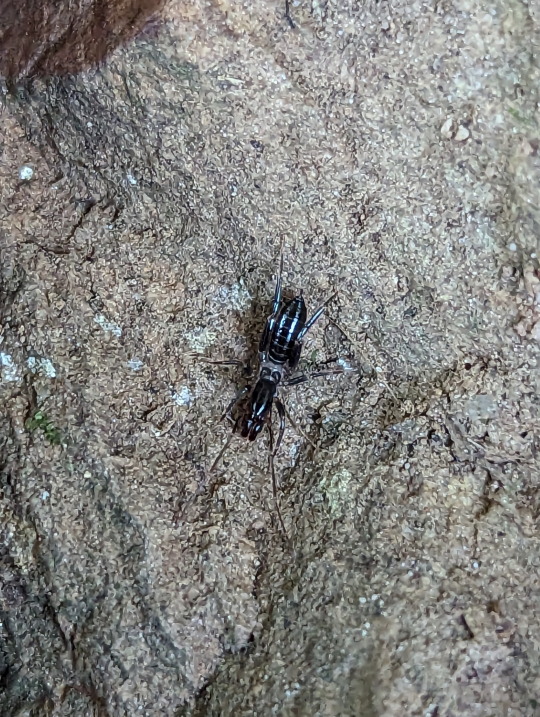

Photos 1-2 - Notozomus ker, female


Photos 3-4 - Notozomus ker, male
Schizomida arachnids (or Shorttailed whipscorpions), identified on iNaturalist as N. ker. using information from Harvey (1992).
For whatever reason there's a lacklustre amount of Australian Schizomida observations on iNaturalist. There's a wide variety of Australian Schizomids out there, with many new species being uncovered fairly recently in Abrams et al. (2019) for example.
Any sort of public record of these arachnids (or just terrestrial arthropods in general) will be very useful, especially since, in general, iNaturalist is lacking observations of Schizomida. Abrams et al. (2019) mentions that there are roughly 350 species of Schizomid out there, but so far, only 23 have been identified on iNaturalist. I feel iNaturalist provides good public records, so the more available on the website, the better.
I'm going to continue flipping over rocks and rotten logs for more Schizomids (and creatures in general), and I implore others to do the same. There's a lot that can be found hiding in the mulch.
*BTW these are not spiders, they're a different Chelicerate entirely.
Sources and further reading:
Harvey, MS 1992 'Schizomida (Chelicerata) of Australia', Invertebrate taxonomy, vol. 6, no. 1, pp. 77-129.
Abrams, KM, Huey, JA, Hillyer, MJ, Humphreys, WF, Didham, RK, Harvey, MS 2019, 'Too hot to handle: Cenozoic aridification drives multiple independent incursions of Schizomida (Hubbardiidae) into hypogean environments', Molecular phylogenetics and evolution, vol. 139, p. 106532.
24/10/23 - Schizomida: Notozomus ker
QLD:WET
#Notozomus ker#arthropods#arthropoda#invertblr#invertebrates#Schizomida#Shorttailed Whipscorpions#entomology#bugblr#bugs tw#bug#bugs#spiders tw#Arachnida#Arachnids#Chelicerata#Chelicerates
82 notes
·
View notes




